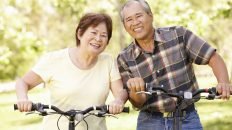By Marc Braman, MD, MPH
MB (Marc Braman, MD, MPH):
Our topic this session is “Diabetes – Why Exercise is Medicine.” I’m Dr. Braman and I am joined by Marc Anderson, a medical student, today.
MA (Marc Anderson):
So, Dr. Braman, we know that exercise is important to help a healthy person stay healthy, but can it help someone with diabetes to better manage their condition.
MB:
Absolutely! Exercise can not only help manage diabetes, but can be part of treating and often curing diabetes. But to really understand how, we should review what diabetes, in particular type 2 diabetes, really is.
Type 2 diabetes occurs when certain cells in your body that store sugar, like muscle and fat cells, become resistant to the effects of insulin which is a hormone that you produce after you eat to help lower your blood sugar levels by telling those cells to store it away for later use. When they become resistant to insulin they stop storing sugar properly and you get high sugar levels in your blood. It is like the doors on the cells have no doorbell or are stuck closed. At first your body makes more insulin to help fight against insulin resistance, essentially knocking harder or trying to kick the door open, but your body becomes more and more insulin resistant over time. The pancreas, the organ that makes the insulin, eventually gets worn out and loses its ability to make it.
MA:
Wow, that’s interesting. So is this why type 2 diabetics often end up needing insulin as well as other medications?
MB:
Yes. Exactly.
MA:
Okay, and isn’t high blood sugar basically toxic to different organs and tissues over time?
MB:
Yes. In a person with long-standing or poorly controlled diabetes the chronic high blood sugar levels damage nerves, small blood vessels all over the body and important organs like your heart and kidneys. Damage to these structures results in many problems including: loss of vision, numbness, foot problems that sometimes lead to amputation, heart disease and chronic kidney failure which can be quite the disaster.
MA:
So how does exercise change the physiology of diabetes? How does it work in the body and at the cell level?
MB:
Good questions. Exercise, apart from diet and medications, both directly and indirectly lowers blood sugars. Exercise not only facilitates the direct use of the sugar in your body to burn as fuel during your workout but, over time, it improves your body’s sensitivity to insulin, helping to make the muscle and fat cells we talked about earlier, process and store sugar more effectively and with less insulin. It gets the cell doors working again, in essence. Twenty to thirty minutes a day spent doing moderate intensity exercise like a fast walk or a family bike ride: lowers blood pressure, decreases weight and body fat, improves the health of your heart, lungs and brain, improves mood, increases energy and strength and improves sleep among many other things.
MA:
Wow, that’s incredible, exercise really is powerful but how powerful can exercise be for dealing with diabetes?
MB:
Many diabetics that adopt a healthy lifestyle which includes a proper diet and regular exercise are able to decrease or eliminate the need for medications, delay and decrease their symptoms and many are able to reverse the disease completely and essentially cure themselves of diabetes!
MA:
That’s amazing, but if exercise is so powerful, then why is diabetes so common and why are there so many people with severe complications from it?
MB:
Unfortunately, only about 12% of diabetics in the U.S. meet the current exercise guidelines that are not only recommended for diabetics but recommended generally for all adults. Unfortunately, the medicine only works when it is used.
The good news is that exercise is medicine for diabetes, and it can be a very powerful part of a lifestyle based treatment plan for the lifestyle disease of type 2 diabetes.
MA:
Well, thank you so much for that, Dr. Braman.
MB:
Thank you for joining us, Marc.
MA:
Absolutely.
Lifelong Exercise Patterns and Cardiovascular Health. Maessen MF, Verbeek AL, Bakker EA, Thompson PD, Hopman MT, Eijsvogels TM. Mayo Clin Proc. 2016 Jun;91(6):745-54. doi: 10.1016/j.mayocp.2016.02.028.
The effects of physical activity on sleep: a meta-analytic review. Kredlow MA, Capozzoli MC, Hearon BA, Calkins AW, Otto MW. J Behav Med. 2015 Jun;38(3):427-49. doi: 10.1007/s10865-015-9617-6.
Resistance and aerobic exercise among adults with diabetes in the U.S. Diabetes Care. Mu L, Cohen AJ, Mukamal KJ. 2014 Aug;37(8):e175-6. doi: 10.2337/dc14-0619.





